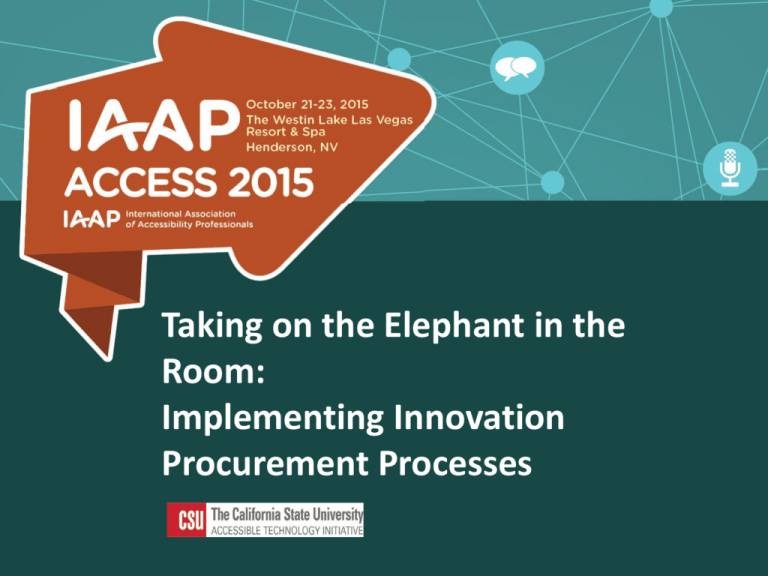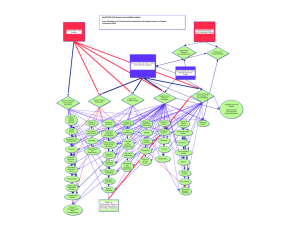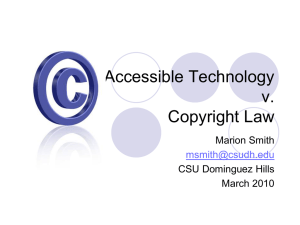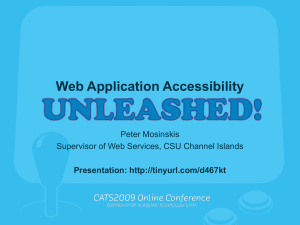Implementing Innovative Procurement Processes
advertisement

Taking on the Elephant in the Room: Implementing Innovation Procurement Processes Speakers: Cheryl Pruitt – Director Accessible Technology Initiative, California State University Sue Cullen – Assistant Director Accessible Technology Initiative, California State University Tom Siechert – ATI Procurement Program Manager California State University, Fresno Getting to know the California State University System • 23 campuses – 460,000 students, 45,000 faculty and staff • Varying Campus Sizes: From 1,000 – 38,000 students • Most ethnically diverse student body in U.S. • Unique campus cultures, human resources, technical expertise • ~ 14,000 students with disabilities registered with our campus disability services offices Expectations • Procuring the most accessible products • Building a culture of accessibility • Promoting institution-wide effort • Driving accessibility improvements to products • Implementing a consistent, repeatable, and effective accessible procurement process The Challenge • Integrating accessibility into the procurement business process • Campuses implement Accessible procurement differently • Different forms • Different processes • Different evaluation techniques • Vendor • Accessibility knowledge • Meeting CSU Accessibility Requirements Breaking down the problem Solutions • CSU Accessible Procurement Process • An accessible procurement process that can be adopted and adapted by CSU campuses • Collaborative outreach with Vendors • CSU Guide to Completing a VPAT and Template • Accessibility Roadmap Template • Accessibility Statement Recommendations What to expect when engaging the CSU. Expectations CSU Expectation Consultation Vendor Expectation Accurate VPAT VPAT Accessibility validation (Demo, Testing) Filled out VPAT Accessibility Road Map Develop Cycle Accessibility Statement Commitment to users Contract Language – to ensure product improvements Contract Improvements based on Road Map Product improvement overall A disconnect occurs when a VPAT is used as a checklist. VPATS Criteria 1194 Supporting Features (use Remarks and Explanations CSU ATN Remarks Enter general comments regarding a product’s “level-ofcompliance” CSU question or concerns defined terms) Describes a specific guideline Enter information summarizing a product’s “level-of support” .21(l) When electronic Supports forms are used... field elements, and functionality including all directions and cues. .41(c) Support Supports services for products shall accommodate the communication needs of end-users with disabilities. All fields are have the FOR Attribute and unique ID. Use the <fieldset> and <legend> elements to group and associate related form controls. Staff are trained in the use of TTY lines and national relay system. Modes include email, phone, chat- chat is an accessible interface. Staff are trained in responding to accessibility related questions Criteria 1194 .22(g) Row and column headers shall be identified for data tables. Supporting Remarks and Features (use Explanations Criteria Table defined terms) Supports .22 (a) text equivalent non-text element .31 (f) fine motor skills Supports with exceptions .22 (d) readable without CSS Supports .31 (b) visual acuity Supports, no known issues CSU ATN Remarks How was this tested? column & row header code used throughout? Some alt text missing Explain Impact Some pages in AB 3.0/4.0 requires the use of mouse. 1194.21(a) is “Supported” for keyboard accessibility This appears to be in conflict. Address if function available in proper order w/o CSS Can text size be enlarged to 200% w/o loss of data and function? Pathway to Inclusion • Enhanced user experience for everyone! • Increased user base • Accessibility Standards increase operability/responsive design • Increased sales - institution looking for compliant products • Socially responsible Tom Siechert • ATI Procurement Program Manager, Senior IT Buyer Fresno State is piloting CSU Accessible Procurement process Pilot @ Fresno State Collaboration with the Accessible Technology Initiative, CSU Office of the Chancellor – Start Date: October 2014 – Real-world proof of concept Deliverables: – – – – – Implement CSU Accessible Procurement process Create training program Launch outreach program and activities; Launch new online forms; and Develop campus capacity to perform hands-on testing Implementing CSU Accessible Procurement • Keys to success: – Easy for end-users to adapt to new processes – Processes aren’t too “heavy” – Processes need to work for both proactive and reactive purchase requests – Processes need to work regardless of funding source • Challenges: – Requisitions are missing key information – Departments expect, are accustomed to fast turnaround – Large numbers of IT-related purchases (>1600 in 2014) The need for IT purchases triage IT-Related Purchases - 2014 1621 700 497 203 Total ICT Individual-Use Review for A11y New Processes to Support Accessible Procurement • Resigned Online Requisition form • Gives ability to intelligently “triage” based upon predefined rules/logic • Pass-through: Non-E&IT, pre-approved, low impact (87%) • Further review needed (13%) • Trigger IT Review form (when appropriate) • IT Review Form • Comprehensive approach to array of Enterprise-level considerations: • • • • Accessibility Information Security Software Licensing Enterprise Support (Implementation & Ongoing) • Works across all business units and funding sources • Users can complete [proactive] or at time requisition is generated [reactive] Online Requisition Screenshot Goals for Accessible Procurement Process • Goal for Step 1: Gather key information about purchases of E&IT • Buy most Accessible product(s) available in market • Exclude low-impact, pre-approved and non E&IT purchases from process • Goal for Step 2: Determine review process, based upon impact • Goal for Step 3: Identify specific Accessibility gaps/barriers • Work with vendors to remediate gaps in reasonable amount of time • Proactively plan for the provision of alternate access • Goal for Step 4: Ensure contract documents include Accessibility requirements and provisions STEP 1: Gather Info [End-user] • Goal: Gather key information about purchases of E&IT • How: • End-User completes IT review form. Accessibility related questions include: • • • • • What is it? Who are the End-Users? How will it be used? How many people will use it? Does the use involve a critical program/benefit? • End-User gets VPAT from vendor STEP 2: Review Info [ATI Designee] • Goal: Determine review process, based upon impact • How: • ATI Designee reviews Accessibility documentation: • IT Review form • VPAT(s) • ATI Designee prioritizes review efforts by impact • Choose review type, tasks STEP 3a: Review Product [ATI Designee] • Goal: Identify specific Accessibility gaps/barriers • How: • ATI Designee and/or other campus staff complete review steps to find, document gaps/barriers. Review steps may include: • • • • • VPAT review Vendor demo Automated testing (Free or Enterprise Tools) Manual testing (Quick or Comprehensive) End-User testing • ATI Designee completes Review Form • ATI Designee completes Summary & Recommendations • Obtain Accessibility Roadmap • Prepare Equally Effective Alternate Access Plan STEP 4: Place Order - no bid [Purchasing Department Buyer] • Goal: Ensure all process steps have been completed, ensure that contract documents include Accessibility requirements and provisions • How: • Buyer completes EIT Buyer Checklist to verify completeness and documentation (e.g. bid documents, process, ATI review processes and recommendations) • Buyer drafts contract documents (General Provisions for IT - including Clause 45, Rider(s) to address Accessibility Roadmap, future testing) STEP 4: Place Order – bid considerations [Purchasing Department Buyer] • Special considerations for bid process: • Ensure bid documents clearly spell-out role of Accessibility • Include Accessibility language in bid specs: • • • • define minimum requirements (e.g. WCAG 2.0 AA, provide VPAT) describe bid process (demo, testing requirements) include accessibility as scored criterion (score based upon narrative, testing, demo) provide an example of required contract language Questions








